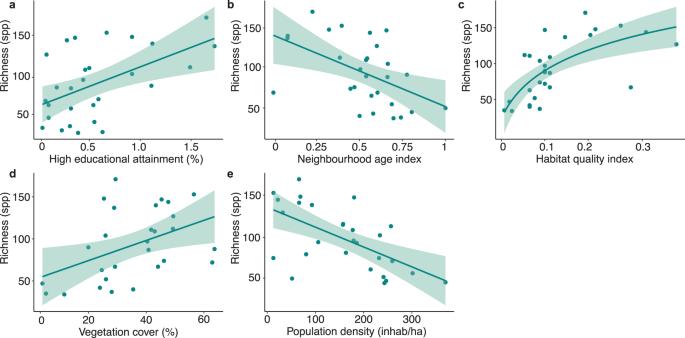Luxury and legacy effects on urban biodiversity, vegetation cover and ecosystem services
IF 8.8
Q1 ENVIRONMENTAL STUDIES
引用次数: 0
Abstract
Socio-economic and historical drivers shape urban nature distribution and characteristics, as luxury (wealth-related) and legacy (historical management) effects. Using remote sensing and census data on biodiversity and socio-economic indicators, we examined these effects on urban biodiversity and vegetation cover in Vitoria-Gasteiz (Basque Country). We also tested the luxury and legacy hypotheses on regulating ecosystem services (ES) and explored predictor interactions. Higher educational attainment positively correlated with urban biodiversity, confirming the luxury effect, but had no effect on vegetation cover or ES. Older areas had higher vegetation cover and ES evidencing a legacy effect with an inverse response on biodiversity, attributable to more recent management strategies promoting biodiversity in green spaces. Habitat quality amplified the luxury effect, while population density strengthened the legacy effect. Our results suggest that urban biodiversity is mainly driven by socio-economic factors, while vegetation cover and ES are influenced by management legacies in interaction with population density.

奢侈品和遗产对城市生物多样性、植被覆盖和生态系统服务的影响
社会经济和历史驱动因素塑造了城市自然分布和特征,如奢侈品(与财富相关)和遗产(历史管理)效应。利用关于生物多样性和社会经济指标的遥感和普查数据,我们研究了这些因素对巴斯克地区维多利亚-加斯蒂斯城市生物多样性和植被覆盖的影响。我们还检验了调节生态系统服务(ES)的奢侈性和传承性假设,并探索了预测因素之间的相互作用。较高的教育程度与城市生物多样性呈正相关,证实了奢侈效应,但对植被覆盖率或生态系统服务没有影响。较老区域的植被覆盖率和 ES 较高,这证明了遗产效应与生物多样性的反向反应,这归因于近期促进绿地生物多样性的管理策略。栖息地质量扩大了奢侈效应,而人口密度则加强了遗产效应。我们的研究结果表明,城市生物多样性主要由社会经济因素驱动,而植被覆盖率和生态系统服务受管理遗产与人口密度相互作用的影响。
本文章由计算机程序翻译,如有差异,请以英文原文为准。
求助全文
约1分钟内获得全文
求助全文

 求助内容:
求助内容: 应助结果提醒方式:
应助结果提醒方式:


